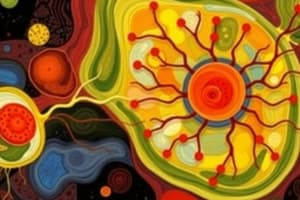Podcast
Questions and Answers
The nervous system is a complex network of specialized cells that transmit messages throughout the body, including the brain, the spinal cord, and an extensive network of ______ that extend into every organ, muscle, and tissue.
The nervous system is a complex network of specialized cells that transmit messages throughout the body, including the brain, the spinal cord, and an extensive network of ______ that extend into every organ, muscle, and tissue.
nerves
The cerebrum, the largest section of the brain, is responsible for higher cognitive functions like thinking, reasoning, and ______.
The cerebrum, the largest section of the brain, is responsible for higher cognitive functions like thinking, reasoning, and ______.
perception
The cerebellum is crucial for ______ and balance.
The cerebellum is crucial for ______ and balance.
coordination
The brainstem, located at the base of the brain, controls vital functions like breathing, consciousness, and ______.
The brainstem, located at the base of the brain, controls vital functions like breathing, consciousness, and ______.
The spinal cord serves as the primary pathway for messages to and from the brain and contains reflex arcs that allow quick responses to external ______.
The spinal cord serves as the primary pathway for messages to and from the brain and contains reflex arcs that allow quick responses to external ______.
Hormonal control is an essential component of control and coordination, involving the regulation of various bodily functions through the release and action of ______.
Hormonal control is an essential component of control and coordination, involving the regulation of various bodily functions through the release and action of ______.
Nerves, the communication lines of the ______ system, transmit messages in the form of electrical impulses from the brain and spinal cord to every part of the body.
Nerves, the communication lines of the ______ system, transmit messages in the form of electrical impulses from the brain and spinal cord to every part of the body.
Sensory nerves carry information about touch, temperature, and pain back to the central nervous system for processing, while motor nerves carry messages from the brain and spinal cord to muscles to facilitate ______ and behavior.
Sensory nerves carry information about touch, temperature, and pain back to the central nervous system for processing, while motor nerves carry messages from the brain and spinal cord to muscles to facilitate ______ and behavior.
The endocrine system is a collection of glands that secrete hormones—chemical messengers—directly into the ______.
The endocrine system is a collection of glands that secrete hormones—chemical messengers—directly into the ______.
For instance, the hypothalamus, a small region at the base of the brain, regulates the pituitary gland, which in turn controls the activity of other endocrine glands like the thyroid, adrenal glands, and ______.
For instance, the hypothalamus, a small region at the base of the brain, regulates the pituitary gland, which in turn controls the activity of other endocrine glands like the thyroid, adrenal glands, and ______.
Reflex action, the rapid, involuntary response to a specific stimulus, is another critical aspect of control and coordination. Reflex arcs, the pathways that carry messages between sensory receptors and effector organs, allow us to respond quickly to external stimuli without ______ thought.
Reflex action, the rapid, involuntary response to a specific stimulus, is another critical aspect of control and coordination. Reflex arcs, the pathways that carry messages between sensory receptors and effector organs, allow us to respond quickly to external stimuli without ______ thought.
The knee-jerk reflex, one of the most well-known reflexes, demonstrates the body's ability to coordinate and respond to external stimuli without ______ effort.
The knee-jerk reflex, one of the most well-known reflexes, demonstrates the body's ability to coordinate and respond to external stimuli without ______ effort.
Study Notes
Control and Coordination: The Workings of Our Body's Regulatory Systems
In the realm of biology, control and coordination encompass the intricate processes by which our bodies regulate, adapt, and maintain a state of balance and harmony. This article will explore three critical components essential to this process: the nervous system, hormonal control, and reflex action.
The Nervous System
At the core of control and coordination lies the nervous system, a complex network of specialized cells that transmit messages throughout the body. This system includes the brain, the spinal cord, and an extensive network of nerves that extend into every organ, muscle, and tissue.
The brain, the central command center, is divided into three main sections—the cerebrum, cerebellum, and brainstem—each responsible for specific functions:
- The cerebrum, the largest and most well-known section, is responsible for higher cognitive functions like thinking, reasoning, and perception.
- The cerebellum is crucial for coordination and balance.
- The brainstem, which lies at the base of the brain, controls vital functions like breathing, consciousness, and alertness.
The spinal cord, a long, narrow, and tubular structure that extends from the brainstem to the lower back, serves as the primary pathway for messages to and from the brain. It also contains reflex arcs that allow us to respond quickly to external stimuli.
Nerves, the communication lines of the nervous system, transmit messages in the form of electrical impulses from the brain and spinal cord to every part of the body. Sensory nerves carry information about touch, temperature, and pain back to the central nervous system for processing, while motor nerves carry messages from the brain and spinal cord to muscles to facilitate movement and behavior.
Hormonal Control
In addition to the nervous system's role in control and coordination, the body's endocrine system also plays a crucial part in maintaining balance and harmony. The endocrine system is a collection of glands that secrete hormones—chemical messengers—directly into the bloodstream.
Hormones act as the body's internal regulators, controlling various physiological processes like growth, metabolism, and reproduction. For instance, the hypothalamus, a small region at the base of the brain, regulates the pituitary gland, which in turn controls the activity of other endocrine glands like the thyroid, adrenal glands, and ovaries/testes.
The endocrine system and the nervous system work together to ensure a balanced internal environment. For example, when the body experiences stress, the hypothalamus releases corticotropin-releasing hormone (CRH), which activates the pituitary gland to produce adrenocorticotropic hormone (ACTH). ACTH then stimulates the adrenal glands to release cortisol, a hormone that helps the body respond to stress and maintain blood sugar levels.
Reflex Action
Reflex action, the rapid, involuntary response to a specific stimulus, is another critical aspect of control and coordination. Reflex arcs, the pathways that carry messages between sensory receptors and effector organs, allow us to respond quickly to external stimuli without conscious thought.
For example, consider the knee-jerk reflex. When a doctor taps the patellar tendon, the reflex arc transmits a message to the quadriceps muscle, causing it to contract and the leg to extend. The knee-jerk reflex, one of the most well-known reflexes, demonstrates the body's ability to coordinate and respond to external stimuli without conscious effort.
Reflex actions are particularly essential for maintaining homeostasis—the body's ability to maintain a stable internal environment. For instance, the cardiovascular system utilizes reflexes to regulate blood pressure, and the digestive system employs reflexes to control the movement of food through the digestive tract.
In conclusion, control and coordination is a complex, multifaceted process that involves the nervous system, hormonal control, and reflex action. These systems work in harmony to maintain balance, adapt to changing circumstances, and ensure the body's ability to function properly. By understanding these processes, we gain a deeper appreciation for the intricate, interconnected nature of our bodies and the complex, yet efficient, mechanisms that underlie our control and coordination.
Studying That Suits You
Use AI to generate personalized quizzes and flashcards to suit your learning preferences.
Description
Explore the intricate workings of control and coordination in biology through the nervous system, hormonal control, and reflex action. Learn how these systems collaborate to regulate bodily functions, adapt to changes, and maintain internal balance.





